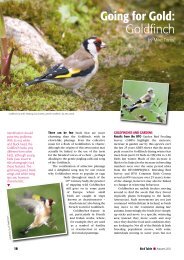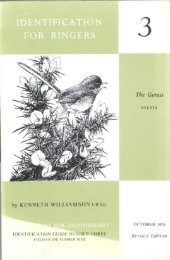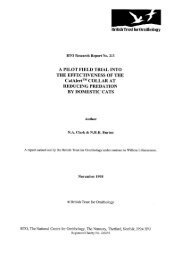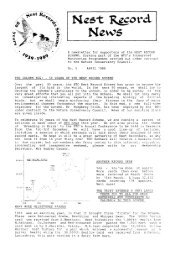Warbler - British Trust for Ornithology
Warbler - British Trust for Ornithology
Warbler - British Trust for Ornithology
You also want an ePaper? Increase the reach of your titles
YUMPU automatically turns print PDFs into web optimized ePapers that Google loves.
40 ACROCEPHALL"S DUMETORUM<br />
Distribution. S. Finland, Baltic countries and Russia south to Ukraine, eastward<br />
across Siberia to Riv. Yenesei; Kirghiz Steppes, Aral-Caspian region,<br />
Transcaspia, E. Iran; Altai Mts eastward to N.W. Mongolia; Turkestan, W.<br />
Tian Shan range, Tadzhikistan, N. Afghanistan. Winters in India south to<br />
Ceylon, east to Assam. Vagrant to <strong>British</strong> Is at Fair Isle (Shetland), late ix. in<br />
1910,1912 and 1928; in 1912 there was a small influx on east coast ofEngland,<br />
but none has occurred in recent years despite an ;:[pparent westwards spread<br />
into Scandinavia. There have been several May-June records in Sweden since<br />
1952. Once Cyprus (Akrotiri, 14.viii.1962).<br />
NOTE: In the first edition, p. 40, I mentioned two specimcns which had<br />
bccn collected in Africa-the first <strong>for</strong> that continent-and misidentified as A.<br />
scirpaceus. They are from Zula, Somalia, 26.i.1952, and Bardai, Tibesti Highlands,<br />
Frcnch Equatorial Africa, 26.iii.1953. In recent years several birds<br />
believcd to bc A. dtlmetorum have been captured inspring at Lake Chad, N.<br />
Nigeria, by A. J. Hopson, J. H. Elgood and P. Ward (23.iii.1963), and by<br />
J. S. Ash, I. J. Ferguson-Lees and H. Fry in March 1967. 1. J. Fcrguson-Lees<br />
and I have compared one of these, togethcr with the two spccimens mentioned<br />
above, with raccs of the African Recd-<strong>Warbler</strong> A. baeticatus, onc of which,<br />
A. b. cillllamOmetls, breeds from Lake Chad north to the Sudan. This is a smaller<br />
bird, especially in tail and tarsus measurements, and is morc rufous than the<br />
specimens in question, which are closest in size and wing-<strong>for</strong>mula to<br />
A. b. suaheliws of E. Africa, though they are olive-tinged on thc mantle and<br />
not foxy red as in that bird. There may well be a hitherto unsuspected<br />
wintering-ground ofA. dl/lnetorum in the Lake Chad region.<br />
THE PADDYFIELD WARBLER<br />
Vaurie (1959, p. 241) divides this species into three races,<br />
nominate agricola, brevipennis (Severtzov) and tangorum La Touche.<br />
The last I believe to be a race ofA. bistrigiceps (see p. 33), and <strong>for</strong><br />
reasons given below I regard brevipennis as a synonym ofagricola.<br />
Thus, assuming there are adequate grounds <strong>for</strong> holding that A.<br />
concinens is specifically distinct, A. agricola is a monotypic species.<br />
Vaurie says the breeding range of the 'nominate' <strong>for</strong>m is unknown<br />
but is suspected to be in India, and that it has been<br />
'examined from November to April from Sind, Kathiawar,<br />
United and Central Provinces, Southern Bombay, Mysore,<br />
Madras and Bhamo in Burma.' Over much the same range<br />
brevipennis, under which name he includes the breeding populations<br />
of Russia, S.W. Siberia, Turkestan etc., is also found in<br />
winter. Nominate agricola differs from this, he says, in being<br />
'more rufous above, less dull and olivaceous, more rusty, less<br />
whitish below'. Confusion has arisen because there are two<br />
colour-phases at this period, as explained below.<br />
A series of]une adults from the Kirghiz Steppes and Astrakhan,<br />
1







